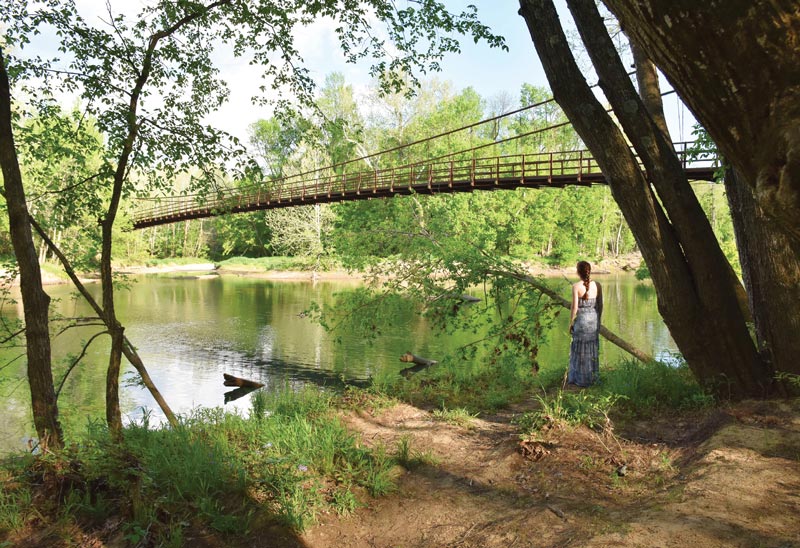Curiosity drives visitors down Swinging Bridges Road. Most come to this gravel backroad while vacationing at Lake of the Ozarks. They get a tip from a local about an old bridge they have to see or maybe something they’ve read sends them out for some real Ozark adventure.
Their quest begins on state Route 42, a winding, hilly two-lane road that some St. Louis folks use as a shortcut to Osage Beach. Others find routes that feel less like a never-ending roller coaster. Swinging Bridges Road meets Route 42 in the wide-spot-in-the-road town of Brumley, a town so small that the bar, the Baptist church, and the post office share a parking lot. It’s a two-mile trek southwest on gravel before visitors reach the grand attraction—one of the longest wire suspension bridges still braved by drivers in Missouri.
The Auglaize Bridge—better known as the Big Swinging Bridge—hangs over the meeting point of Grand Auglaize Creek and Lake of the Ozarks. The bridge was built in 1931—the same year Union Electric completed Bagnell Dam to create the Lake of the Ozarks.

Today, many visitors take one look at the rust-covered 88-year-old bridge and decide only a crazy person would take a vehicle onto such an antiquated structure. For one thing, it’s so long—414 feet stretched across the water with no supports below. Then there’s the deck—8-by-2-foot oak boards spaced inches apart. To make matters worse, it’s a one-lane bridge, and an arch in the middle forces cars on opposite ends to play peek-a-boo. You could get 100 feet out there and then have to back up!
Such astonishment brings the locals much mirth. Having crossed the bridge hundreds of times, they don’t see it as an adventure. For them, it’s the way home.
“I use it regularly for family photos, prom pictures, or a day out with the grandkids,” says Bonnie Pryor, district manager for Miller County Soil and Water Conservation. “We travel across it in an automobile without a thought of safety to go kayaking, swimming, and for scenic drives.”
Decades ago, the Big Swinging Bridge was one of dozens of wire suspension bridges in Missouri, most of which were built by the same man.
Joseph A. Dice participated in the construction of more than 40 wire suspension bridges in mid-Missouri between 1895 and 1940. Suspension bridges are also known as swinging bridges because with no underneath support, they really do swing. Dice hung his bridges on massive steel wire cables running between two towers. The cables create a catenary chain—the curve produced when a flexible wire hangs from two fixed supports. Vertical suspender cables connect the bridge’s deck to the catenary chain. These suspender cables get shorter toward the bridge’s middle, creating the deck’s arch. Besides adding to the excitement (or terror) of crossing the bridge, this arch allows the deck to flatten a little with heavy loads, enhancing the bridge’s strength.

But the most important factor in the bridge’s strength is the catenary chain. Getting the curve wrong would weaken the bridge and could even cause a main cable to break. Engineers determine the correct curve through a complex mathematical formula, but Dice, who attended school only until the eighth grade, was not acquainted with the formula’s workings.
In fact, a 1980 history of the US Army Corps of Engineers reports that no one who worked with Dice ever saw him ask for advice or figure his curves with a pencil and paper. Instead, he simply strung twine between tall trees on opposite banks to find the basic curve. When the curve looked right to him, he marked the length of the twine, noted the heights, and proceeded to build his bridge. Several decades later, no main cable has ever snapped. Dice and his ball of twine hold a perfect record.
When a vehicle rolls onto the Big Swinging Bridge, Dice’s engineering still allows the vertical cables to respond with a bit of give. That downward movement causes the bridge to rock a little from end to end and sets off a wave of motion on the bridge’s deck. Just like water in front of a boat, the deck in front of the vehicle rolls up and forward. And just like with water, cars moving with the bridge’s wave don’t feel the up-and-down motion, but drivers who stop do feel it.
Sightseers may not like that feature, but locals do.
A Facebook post from local resident John Neal illustrates the special place of bridges like this in the hearts of area natives. He shared: “Gotta love them swinging bridges, grew up on, dived off of, fished under, kissed girls under, but the best was giving Mrs. Sullivan and friend a ride over on my car hood. Teacher lady said a couple off-color words as I sped up and giggled the rest of the time.”

The Clock is Ticking
For those who dare, now is the time to get your thrills and giggles on the Auglaize Bridge. The era of swinging bridges is fast coming to a close in Missouri. National Bridge Inventory, a database compiled by the Federal Highway Administration, provides an inspection report from January 2017, and it’s not encouraging for the future of the 88-year-old bridge. Condition is rated “poor,” and the structural appraisal is “basically intolerable requiring high priority of replacement.”
And there’s the rub. Miller County is responsible for upkeep of the Big Swinging Bridge. County Commissioner Tom Wright says the bridge is likely to be placed out of service within the next two years. Options are to close it or to replace it at a cost of more than $2.5 million, an unlikely priority for the county’s budget. But because the bridge provides access to part of Lake of the Ozarks State Park, the county has notified the Department of Natural Resources that it may be placed out of service. Perhaps, Tom says, there’s an option for Missouri State Parks to assume responsibility for the bridge and maintain it as a footbridge.
Miller County’s two other swinging bridges—Mill Creek Bridge, which motorists must cross to reach the Big Swinging Bridge, and Kemna Bridge near St. Elizabeth—still take vehicle traffic. Those two are in good repair, Tom says. “Our attention is on the big one.”
A local effort to preserve the Big Swinging Bridge is another possibility, says Dennis Heckman, bridge engineer for the Missouri Department of Transportation. He points to the state-maintained Little Niangua Swinging Bridge in Camden County, one of the few swinging bridges in Missouri that Joe Dice did not design. MoDOT is building a stationary replacement bridge right next to it on Route J two miles west of Greenview. The project will give Camden County time to explore preserving the Little Niangua as a pedestrian bridge.
In Benton County, the Joe Dice Swinging Bridge at Warsaw is open only to pedestrians. The nearly 600-foot bridge over the Osage River was built in 1904 and rebuilt in 1928 after a tornado destroyed the original. Known as the “Upper Bridge,” it is the last of 15 swinging bridges that once crossed the Osage River on a highway system that linked the Great Lakes with the Gulf of Mexico. The bridge was placed on the National Register of Historic Places in 1999. Numerous trails from Drake Harbor connect to and from the Swinging Bridge for bicyclists, walkers, and hikers.
Related Posts
If You Love Something, Lock It Up On This Kansas City Bridge
Minor Park's Old Red Bridge in Kansas City brings an old world tradition to the midwest.
New & Renovated Memorials, Road Signs Across Missouri Honor Veterans
An inaugural Veterans Day ceremony will take place November 11 at Missouri’s National Veterans Memorial. The event offers a way to remember those lost or serving in the military by securing a personalized Gold or Blue Star badge to be incorporated into the ceremony as service flags.
Read Up on 21 Independent Bookstores Across the State
An independently owned bookstore is like a friend: it has its own personality that makes you love to spend time there. Despite the draw of web-based super sellers, indie bookstores are surviving.



